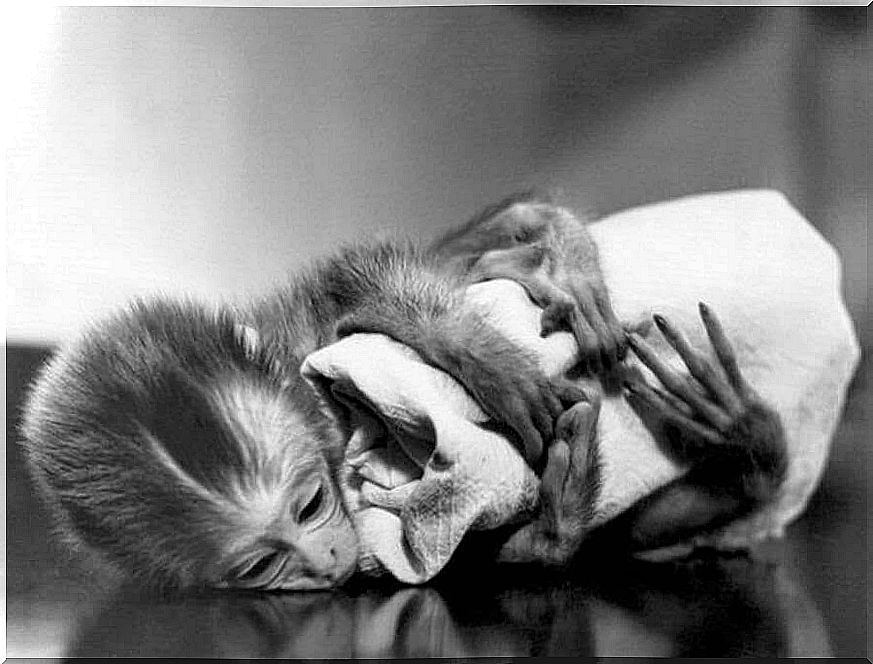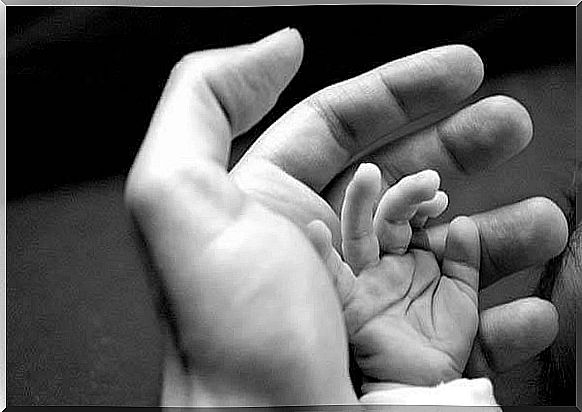Harlow’s Experiment And His Attachment Theory

Attachment theory focuses on the psychological phenomena that occur when we form emotional bonds with other people. How we do this will be conditioned on how our parents related to us during childhood. Thus, many times, if the relationship was not positive, some types of toxic relationships or relationships that end in emotional dependence may end up happening.
Bowlby was the forerunner of this attachment theory and found that maternal deprivation can seriously affect babies. Getting to be so harmful that, even, children could acquire an intellectual delay and assimilate a very bad way of relating to emotions. Harlow, an American psychologist, decided to prove Bowlby’s attachment theory by performing an experiment that many, if not all, consider cruel.
The experience with rhesus monkeys
Harlow used Rhesus monkeys in his experiment, an Asian species that gets used very easily to living with humans. The intention was to study their behavior in the laboratory to prove Bowlby’s attachment theory. As expected, Harlow separated the puppies from their mothers to see how they reacted.
But Harlow didn’t just watch what happened, he used a curious methodology. There were two objects in the cages where the puppies were: a bottle that provided them with adequate food and a stuffed animal, a doll, that resembled an adult monkey. The stuffed animal had no food resources to offer the puppy.

What did the puppies choose? This was something Harlow wanted to discover not only to prove Bowlby’s attachment theory, but also to discover the reality of unconditional love. The result showed how the puppies preferred the doll, despite it not providing them with any food.
This allowed Harlow to see how the relationship/attachment is so important between puppies and their mothers. Despite not feeding them, they chose the doll so that he would adopt the role of mother. They preferred to spend their time with the puppet. The other object was a mere food that gave them neither warmth nor affection.
The Most Painful Attachment Theory
Harlow didn’t settle for everything he’d already proven. He decided to go further, without taking into account the well-being of the Rhesus monkeys. He placed them in even smaller spaces, where there was only food and drink. That way he could observe how they would behave in absolute isolation.
Many monkeys were trapped inside these small cages for months, some even years. Deprived of all social and sensory stimuli, the monkeys began to show changes in their behavior as a result of all this isolation. The monkeys that had been imprisoned for a year were in a catatonic state. They were passive and indifferent to everything and everyone.
When the trapped monkeys reached adulthood, they could not relate to each other correctly. They did not find partners, they had no need to procreate and, on some occasions, their passivity made them stop eating and drinking. Many died.

The females were even less lucky, if we may say so. By taking his research to the extreme, Harlow realized that females could not get pregnant, as they had no interest in procreating. For this reason, in a support for forced reproduction, he fertilized the females against their will and interest.
To generate attachment you need attachment
The result was completely terrifying. The violated mothers were completely at odds with their puppies, ignored them, did not feed them, definitely did not love the puppies. So much so that many of them mutilated their young so that they would die.
In addition to verifying or not verifying Bowlby’s attachment theory, what Harlow’s macabre experiment made clear is that the monkeys’ needs went far beyond obtaining food or the possibility of rest. For healthy development, puppies preferred to supply the need for “heat” before their nutritional needs.
On the other hand, this experience also made clear the importance of early relationships in the behavior of monkeys in their adult phase. Thus, it was seen that the deprivation of a social stimulus at very young ages made the monkeys lose interest in this type of contact later, when they had the opportunity.

The deprivation of affection in human beings
Taking these conclusions to human beings, children who do not receive the necessary affection from an early age, who find themselves isolated or who are rejected, have more difficulties in developing healthy relationships. A failure that cannot be erased, that leaves lack of affection and a need to look for someone who will provide them “at any cost” with what they did not have during their first years of life. We’re talking about emotional addiction, of course.
* Editorial note : fortunately nowadays the ethical requirements that a research must meet, whether with people or animals, are much stricter and this terrible experiment could not be carried out in any way. Unfortunately, we cannot repair the torture these animals were subjected to either, but we can make their suffering be honored, not forgetting what they taught us.








